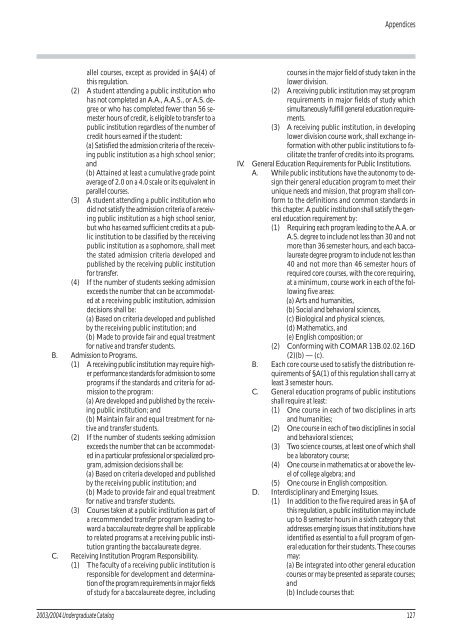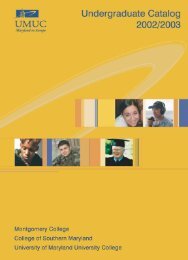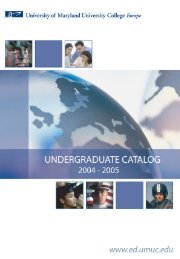Undergraduate - UMUC Europe
Undergraduate - UMUC Europe
Undergraduate - UMUC Europe
Create successful ePaper yourself
Turn your PDF publications into a flip-book with our unique Google optimized e-Paper software.
allel courses, except as provided in §A(4) of<br />
this regulation.<br />
(2) A student attending a public institution who<br />
has not completed an A.A., A.A.S., or A.S. degree<br />
or who has completed fewer than 56 semester<br />
hours of credit, is eligible to transfer to a<br />
public institution regardless of the number of<br />
credit hours earned if the student:<br />
(a) Satisfied the admission criteria of the receiving<br />
public institution as a high school senior;<br />
and<br />
(b) Attained at least a cumulative grade point<br />
average of 2.0 on a 4.0 scale or its equivalent in<br />
parallel courses.<br />
(3) A student attending a public institution who<br />
did not satisfy the admission criteria of a receiving<br />
public institution as a high school senior,<br />
but who has earned sufficient credits at a public<br />
institution to be classified by the receiving<br />
public institution as a sophomore, shall meet<br />
the stated admission criteria developed and<br />
published by the receiving public institution<br />
for transfer.<br />
(4) If the number of students seeking admission<br />
exceeds the number that can be accommodated<br />
at a receiving public institution, admission<br />
decisions shall be:<br />
(a) Based on criteria developed and published<br />
by the receiving public institution; and<br />
(b) Made to provide fair and equal treatment<br />
for native and transfer students.<br />
B. Admission to Programs.<br />
(1) A receiving public institution may require higher<br />
performance standards for admission to some<br />
programs if the standards and criteria for admission<br />
to the program:<br />
(a) Are developed and published by the receiving<br />
public institution; and<br />
(b) Maintain fair and equal treatment for native<br />
and transfer students.<br />
(2) If the number of students seeking admission<br />
exceeds the number that can be accommodated<br />
in a particular professional or specialized program,<br />
admission decisions shall be:<br />
(a) Based on criteria developed and published<br />
by the receiving public institution; and<br />
(b) Made to provide fair and equal treatment<br />
for native and transfer students.<br />
(3) Courses taken at a public institution as part of<br />
a recommended transfer program leading toward<br />
a baccalaureate degree shall be applicable<br />
to related programs at a receiving public institution<br />
granting the baccalaureate degree.<br />
C. Receiving Institution Program Responsibility.<br />
(1) The faculty of a receiving public institution is<br />
responsible for development and determination<br />
of the program requirements in major fields<br />
of study for a baccalaureate degree, including<br />
Appendices<br />
courses in the major field of study taken in the<br />
lower division.<br />
(2) A receiving public institution may set program<br />
requirements in major fields of study which<br />
simultaneously fulfill general education requirements.<br />
(3) A receiving public institution, in developing<br />
lower division course work, shall exchange information<br />
with other public institutions to facilitate<br />
the tranfer of credits into its programs.<br />
IV. General Education Requirements for Public Institutions.<br />
A. While public institutions have the autonomy to design<br />
their general education program to meet their<br />
unique needs and mission, that program shall conform<br />
to the definitions and common standards in<br />
this chapter. A public institution shall satisfy the general<br />
education requirement by:<br />
(1) Requiring each program leading to the A.A. or<br />
A.S. degree to include not less than 30 and not<br />
more than 36 semester hours, and each baccalaureate<br />
degree program to include not less than<br />
40 and not more than 46 semester hours of<br />
required core courses, with the core requiring,<br />
at a minimum, course work in each of the following<br />
five areas:<br />
(a) Arts and humanities,<br />
(b) Social and behavioral sciences,<br />
(c) Biological and physical sciences,<br />
(d) Mathematics, and<br />
(e) English composition; or<br />
(2) Conforming with COMAR 13B.02.02.16D<br />
(2)(b) — (c).<br />
B. Each core course used to satisfy the distribution requirements<br />
of §A(1) of this regulation shall carry at<br />
least 3 semester hours.<br />
C. General education programs of public institutions<br />
shall require at least:<br />
(1) One course in each of two disciplines in arts<br />
and humanities;<br />
(2) One course in each of two disciplines in social<br />
and behavioral sciences;<br />
(3) Two science courses, at least one of which shall<br />
be a laboratory course;<br />
(4) One course in mathematics at or above the level<br />
of college algebra; and<br />
(5) One course in English composition.<br />
D. Interdisciplinary and Emerging Issues.<br />
(1) In addition to the five required areas in §A of<br />
this regulation, a public institution may include<br />
up to 8 semester hours in a sixth category that<br />
addresses emerging issues that institutions have<br />
identified as essential to a full program of general<br />
education for their students. These courses<br />
may:<br />
(a) Be integrated into other general education<br />
courses or may be presented as separate courses;<br />
and<br />
(b) Include courses that:<br />
2003/2004 <strong>Undergraduate</strong> Catalog 127






